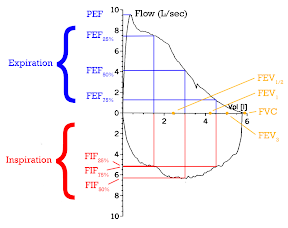FEF25-75 gets another look: Forced midexpiratory flow between 25% and 75% linked to asthma persistence
 Forced midexpiratory flow between 25% and 75% of forced vital capacity (FEF25-75) is associated with long-term persistence of asthma and poor asthma outcomes.
Forced midexpiratory flow between 25% and 75% of forced vital capacity (FEF25-75) is associated with long-term persistence of asthma and poor asthma outcomes.Whether small-airway obstruction contributes to the long-term evolution of asthma remains unknown.
This French study assessed if forced midexpiratory flow between 25% and 75% of forced vital capacity (FEF25-75) was associated with the persistence of current asthma over 20 years and the subsequent risk for uncontrolled asthma independently of FEV1.
The study included 337 patients with asthma (asthma attacks or treatment in the past year, 142 children and 225 adults). The patients were followed up at the 12- and 20-year surveys.
Decreased FEF25-75 at the onset of the study increased the risk of:
- long-term asthma persistence, but only slightly (adjusted odds ratio (OR), 1.14)
- more severe bronchial hyperresponsiveness and current asthma a decade later (OR between 1.21 and 1.44)
Small-airway obstruction, as assessed based on FEF25-75, might contribute to the long-term persistence of asthma and subsequent risk for poor asthma outcomes, independently from FEV1.
References:
Forced midexpiratory flow between 25% and 75% of forced vital capacity is associated with long-term persistence of asthma and poor asthma outcomes. Siroux V et al. J Allergy Clin Immunol. 2015 Dec 11. pii: S0091-6749(15)01635-8. doi: 10.1016/j.jaci.2015.10.029. [Epub ahead of print]
http://www.ncbi.nlm.nih.gov/pubmed/26688518
The World Allergy Organization (WAO) Small Airways Working Group publishes a monthly "What's New?" summary and I have served as its editor since 2011. The summary features the top 3 asthma/small airways articles each month. The article above is a part of the project. The archive is here: http://www.worldallergy.org/small_airways_group/reviews/archive.php
Image source: Spirometry, from Wikipedia, the free encyclopedia, GNU Free Documentation License.